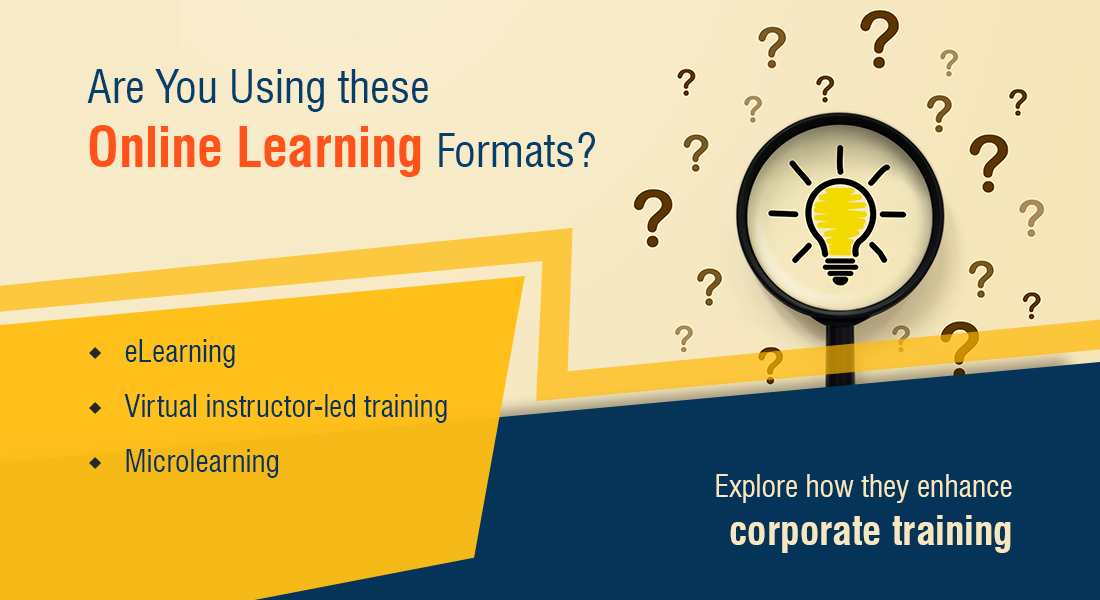How Do You Ensure the Quality of eLearning Courses?

According to the E-Learning Trends 2019 report by Docebo, the corporate online learning market is expected to grow at a CAGR of 11.41% between the years 2018 and 2021. Needless to say, eLearning adoption has gained momentum ever since enterprises have started considering eLearning as a viable solution to their productivity and budget-related issues. Why?
→ Download Now: Instructional Design Strategies to Design Engaging eLearning Courses
Answer these 6 questions to ensure quality in eLearning courses
- Do your eLearning courses leverage adult learning principles? s
- Are the learning objectives relevant to learners’ performance?
- Does your eLearning course match your corporate branding?
- Are your eLearning courses mobile-friendly?
- Are onscreen text and audio narration optimized?
- Is the course tested on the LMS and does it offer detailed metrics?
Technology improvements and changing business requirements have boosted digital learning solutions at the expense of conventional learning methods which tend to be costly and tedious. However, despite these numbers speaking volumes in favor of eLearning solutions, there are organizations that are skeptical and express concerns about its effectiveness. Well, one way to reduce this skepticism is to ensure adequate quality standards in your eLearning programs and prove they can fulfill the unique training needs of your organization. How to do that?
Here are 6 questions you need to answer if you want to ensure quality of your eLearning programs.
Questions to Ensure Quality in eLearning Courses
1. Do Your eLearning Courses Leverage Adult Learning Principles?
In 1968, Malcolm Knowles proposed the Adult Learning Theory which acknowledges the way adults learn. Designing an online learning program for adults is significantly different from lesson planning for children. However, just as children, adults too have to be engaged using a variety of digital learning methods.
Well, leveraging adult learning principles is imperative and paves way into their minds, thus ensuring the development of quality eLearning solutions that are learner-worthy!
Adult Learning Principles for Quality eLearning Solutions
Adults are innately motivated and self-directing. They prefer to have a sense of control on their own learning. For instance, restricting the course navigation might put off learners which would have been otherwise if the course gave them autonomy and opportunities for independent thinking.
Adults have their own set of existing knowledge, beliefs, and experiences, having lived through complex situations. When the eLearning course leverages your learners’ current knowledge:
- You are orienting them toward new knowledge and making the learning content more relatable.
- This is also a good way to portray value and respect to that experience.
Adult learners are goal-oriented. This implies adults will be more interested in learning if they see a payoff at the end. This includes offering learning solutions that can help them in:
- Doing their job better
- Resolving problems
Since adult learners often face time-crunch, they seek learning content that is relevant and related to their performance needs. This implies you need to ensure the course includes contextual learning
Adult learners seek opportunities to apply their newly-acquired knowledge. They prefer to be active participants instead of passive. Hence, include adequate interactivities in eLearning courses. Discussions, quizzes, group assignments etc. – practical activities that facilitate better learning.
2. Are the Learning Objectives Relevant to Learners’ Performance?
You don’t want your learners to mistake an eLearning course to be any get-rich-quick source. Rather, you want your learners to know what they are signing up for. The learning objectives in an online course should clearly describe what learners will be able to achieve upon completion. This implies being clear on what your online learning program has in store for them and how much commitment will be required for them to achieve the desired goal.
To ensure the learning content is of quality and relevant to learners’ performance, setting the learning objectives is the first step before heading for course design. This also helps in deciding what content to include and what to leave out. Ensure you have the 3 components in your learning objectives, as proposed by Dr. R F Mager.
3 Components a Good Learning Objective Should Have
- Performance – describes – what a learner will be able to do
- Conditions – refers to the situation in which the learner is expected to perform
- Criteria – describe the level of competence that must be achieved to succeed
Although it might be cumbersome to include conditions and criteria, it is imperative that the learning objective include a measurable and tangible performance parameter.
3. Does Your eLearning Course Match Your Corporate Branding?
If you thought branding is important only to specific manufacturers belonging to fast-moving consumer goods, luxury watches, cars etc., it’s time to reconsider.
In a world of distraction, branding ensures your learners recognize you as an authority and focus on the learning content. With the pressing need to keep your employees updated with the latest industry knowledge, branding will help in ensuring your online learning courses aren’t lost in the crowd and maintain adequate quality standards.
Here are some branding elements that will help in lending consistency and credibility among your learners. Additionally, it will ensure a high-quality eLearning experience that meets your learners’ expectations.
Branding Elements to Ensure Quality eLearning Experience
- Logo
- Color scheme
- Legible typography
- Thematic templates
- Personalized images
- Themed navigational controls

Instructional Design Strategies to Design Engaging eLearning Courses
Design Learner-Centric eLearning
- Importance of ID Strategies in eLearning
- Parameters to Select the Right ID Strategy
- ID Strategies for Effective Results
- Case Studies
4. Are Your eLearning Courses Mobile-friendly?
According to a report by Google, 57% of people switch between different devices, be it desktops, tablets or smartphones. This implies having device-agnostic eLearning courses is no more an option if you want to keep up with the dynamic learning requirements.
Factors to Up the Quality of mLearning Courses
When it comes to implementing mLearning, there is no room for extraneous information and cluttered design. Having them might put off learners while sifting through unnecessary information. Additionally, cluttered design makes it harder to navigate the course. Ensure your course has adequate white space, crisp, and digestible content layout that prevents cognitive overload.
Bandwidth constraints often limit mobile learning. For instance, lower speed on a Wi-Fi connection. Images that otherwise show up instantly on a high-speed Internet take longer to load on smartphones. Hence, ensure all multimedia elements such as eLearning videos, images, infographics, etc., are compressed and optimized for mobile view.
Navigation is definitely a critical element of any online learning solution. Clear and easy navigation in eLearning allows self-directed learning, enables learners to explore and read just the content they need. Unclear navigation will frustrate learners. So ensure the navigational icons are clearly visible and easy to tap. Instead of conventional menu bars, opting for a drop-down menu bar is a good option for mobile learning.
5. Are Onscreen Text and Audio Narration Optimized in Your eLearning course?
Audio can be one of the ways to explain your content and add life to it. Audio narration in eLearning can be used three ways:
- In-depth narration, with onscreen text being the summary of what is being said
- In-depth text on the screen and audio narration providing additional information
- Graphics/animations onscreen, with audio narration used to explain images or graphics
However, when used badly, audio has the potential to distract and irritate learners, as well as confuse the working memory –which implies hindrance to learning.
Factors to Ensure Quality While Using Audio Narration in eLearning
- Audio narration should only be used when it can complement and support onscreen content – be it visual or text
- The audio narration should match with onscreen text or provide a gist of it
- Onscreen visuals/animations should fade in and out in sync with audio
- Ensure the sound quality of the audio files is up to the mark. It should be devoid of any background sound, fuzz, etc.
- Ensure audio volume consistent throughout the course
6. Is the Online Course Tested on the LMS and Offer Detailed Metrics?
One of the best practices while ensuring the eLearning quality is to test it on the Learning Management System (LMS) before the final launch. It is important that your eLearning vendor test the course on all devices before launching, as well as generate reports from the LMS to prove it tracks properly. This allows rectifying mistakes which would have negatively impacted quality and hindered smooth learning if disseminated.
Reasons to Test an eLearning Course on the LMS
- To ensure the course is compatible with the various devices and browsers your learners are expected to use
- To check if the course is compatible with the required eLearning technology standard such as SCORM or xAPI
- Completion Tracking: To Determine if the course will show pass/fail, complete/incomplete, and other status and other reporting metrics accurately
- To confirm if the course returns learners to the slide last visited (bookmark)
Needless to say, eLearning is an effective way of learning. However, it has its own share of associated costs and demands. It is important to design e-learning in a way that it provides the maximum possible return on investment. When you find answers to these questions, you will achieve quality eLearning courses that are cost-worthy as well as learner-centric!




![How to Design Impactful eLearning? Unveil the Secrets [Comprehensive Guide]](https://blog.commlabindia.com/hubfs/blogs/elearning-impactful-design-aspects-info.jpg)
